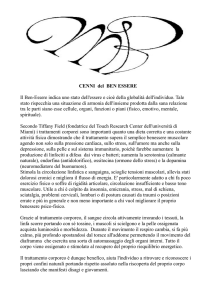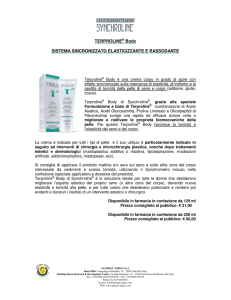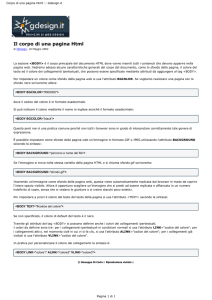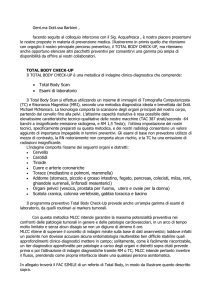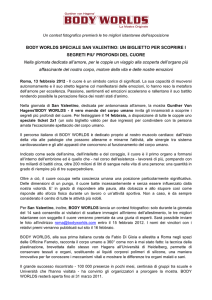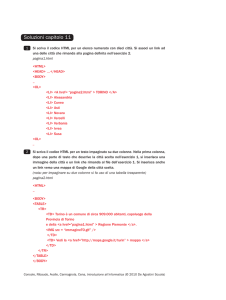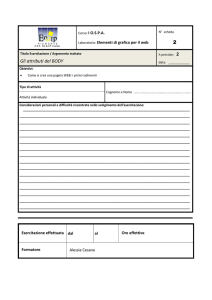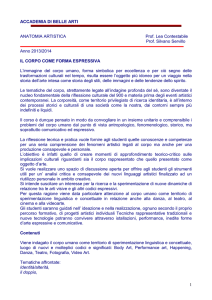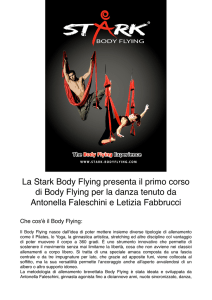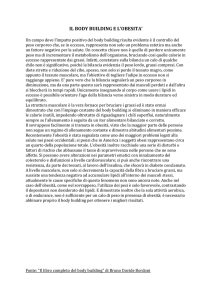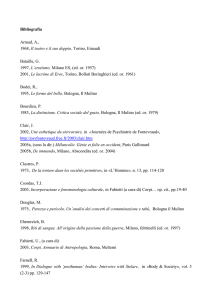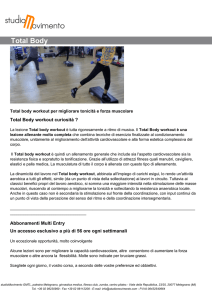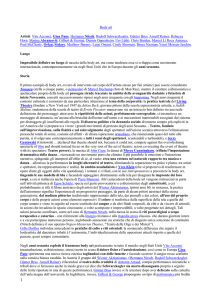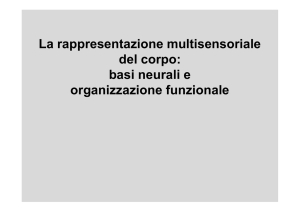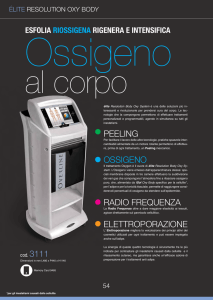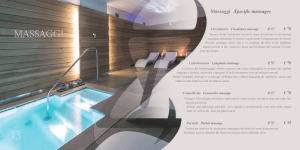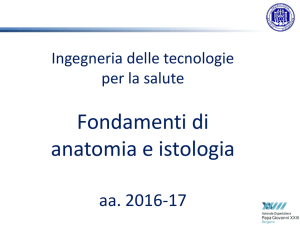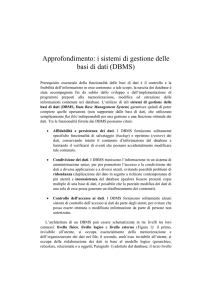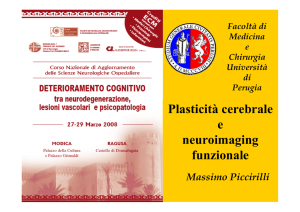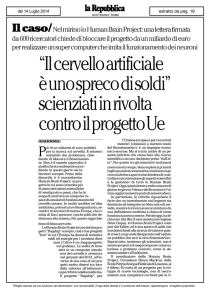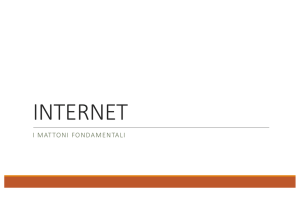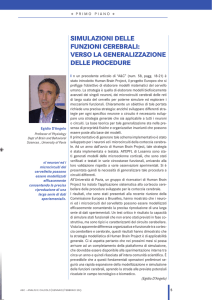A.S. 2015 2016
annuncio pubblicitario
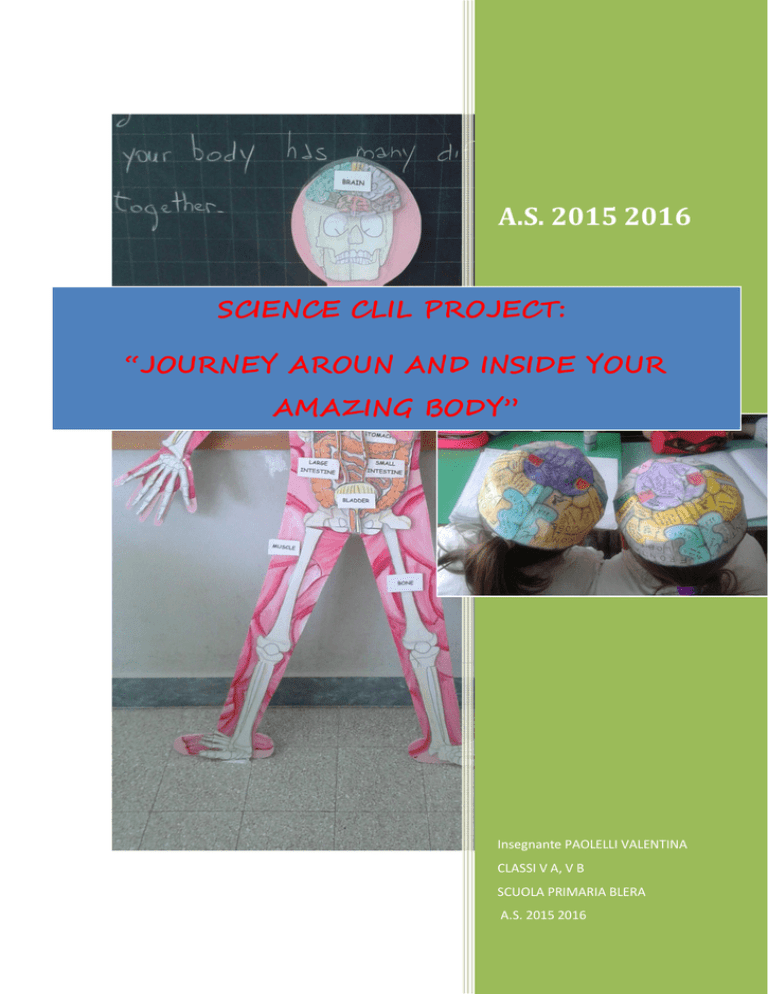
A.S. 2015 2016 SCIENCE CLIL PROJECT: “JOURNEY AROUN AND INSIDE YOUR AMAZING BODY” Insegnante PAOLELLI VALENTINA CLASSI V A, V B SCUOLA PRIMARIA BLERA A.S. 2015 2016 SCIENCE CLIL PROJECT: “JOURNEY AROUN AND INSIDE YOUR AMAZING BODY” Referente del progetto Paolelli Valentina Obiettivi Potenziare l’apprendimento della lingua inglese, usata come mezzo per conoscere, approfondire ed esprimere i contenuti della disciplina presa in considerazione (Scienze, il corpo umano) ed incrementare la conoscenza della stessa attraverso la metodologia CLIL. Riconoscere e nominare le varie parti del corpo, saperle descrivere e spiegare la loro funzione. Realizzare una dispensa del lavoro svolto ed un plastico del corpo umano. Destinatari Classi 5 A , 5 B. 32 alunni di cui 2 alunni H 1 alunna Bes Durata del progetto Il progetto si è svolto da Dicembre a maggio, in orario curricolare, per un’ora a settimana, trasversalmente alle lezioni di scienze e inglese. Modalità e tempi di attuazione. Ogni argomento è stato presentato agli alunni prima in lingua italiana, come da programmazione, in seguito in lingua inglese, attraverso flash cards, songs, filmati, materiali LIM o cartacei. Gli alunni hanno acquisito la terminologia basilare della materia in L2, padroneggiando così semplici termini e frasi. Parallelamente le due sezioni hanno lavorato a classi aperte, realizzando di un plastico dove, di volta in volta, hanno riprodotto le parti del corpo studiate, fino al suo completamento. Al termine del lavoro ogni alunno ha raccolto i propri materiali una piccola dispensa ed ha partecipato all’elaborazione di un video finale. Mese Dicembre Gennaio Febbraio Marzo Aprile Maggio Programmazione scienze Il corpo umano, cellule e tessuti L’apparato locomotore L’apparato digerente L’apparato respiratorio L’apparato circolatorio L’apparato escretore Il sistema nervoso Gli organi di senso Science CLIL The human body, it all starts with cells Your skeleton Muscle power Your digestive system Breathing The heart Your blood Waste disposal A brain tour Eyes and ears Follow your nose Tasty! FASI DEL LAVORO 1 LA REALIZZAZIOME DELLA SAGOMA DEL CORPO UMANO : sagoma di compensato altezza 1,50 circa 2 RICERCA ED ELABORAZIONE VARI APPARATI E ORGANI (vedi materiali 3 da ingrandire A3) 3 Scrittura al computer e a mano delle funzioni di ogni apparato, ricerca delle parole chiave da inserire nel progetto finale, (vedi materiali 1 e 2) 4 PLASTIFICHIAMO! Plastificazione dei vari organi che comporranno il progetto e verranno poi applicati sulla sagoma con il velcro, ciò permetterà agli alunni di staccarli e riattaccarli ogni volta e renderà il lavoro fruibile anche per le classi a venire. 5 Assemblaggio delle varie parti costituenti l’elaborato finale. 6 LA DISPENSA FINALE. Sagoma pieghevole (vedere materiali 4 da imgrandire A4) 7 I NOSTRI CERVELLI. (vedi materiali 5) Creazione di un cappello rappresentante il cervello umano con la differenziazione delle diverse aree in L2 8 CREAZIONE DI UN VIDEO ESPLICATIVO MATERIALI Materiale 1 Journey around and inside your amazing body Your body is an incredible living, breathing, moving, eating, talking, thinking machine. Look closer and you'll discover that your body has many different parts , all working together. The Skeleton My skeleton gives my body shape, protects my organs and allow me to move. I have 206 bones in my body. The muscle power Muscles work by pulling. Loads of tiny muscle cells work together to make it move Under your skin Your skin provides a tough, flexible covering for your body. Your skin is your body's largest organ. Digestive system When you eat your dinner, the food starts a long journey through your body’s digestive system. The food get squished into the stomach. It arrives in the small intestine. At the end the food goes into the large intestine. The leftover food is turned into poo ready to live your body. The urinary system So, what happens to the water you get from food? The water you get from food travels into your kidneys. Extra water and chemicals waste travel out trough the ureter to your bladder as urine. My lugns and respiratory system: The air I breathe in, goes down my trachea to my lungs. My body needs oxygen from the air to live. I breathe out a gas called carbon dioxide that my body does not need. My heart My heart is a muscle that pumps blood through my body. Arteries carry blood away from my heart. Veins carry blood to my heart. Your blood network Each time your heart beats, it pumps blood all around your body. The blood flows through a network of tubes called blood vessels. The brain Your brain is made up of many parts and the brain cells in different areas of the brain have special jobs. Thinking and planning, speaking, feelings, hearing, taste, controlling muscles, touch, reading, seeing and balance. Sending messages: Your nerve network. A network of cells called nerves carries information and messages between your body and your brain . It's called the nervous system and it's super fast. It carries information from your eyes, ears, tongue, nose and touch sensor Materiale 2 LUNGS HEART SMALL INTESTINE LARGE INTESTINE LIVER BLADDER KIDNEY BONE STOMACH MATERIALE 3 MUSCLE BRAIN MATERIALE 4 MATERIALI 5
